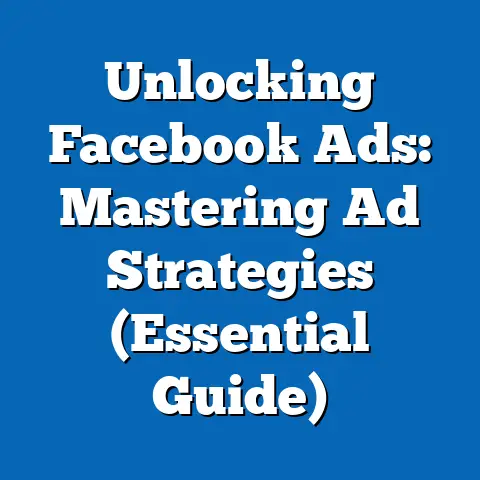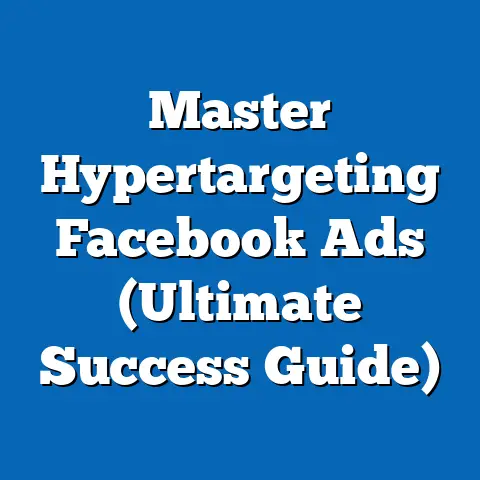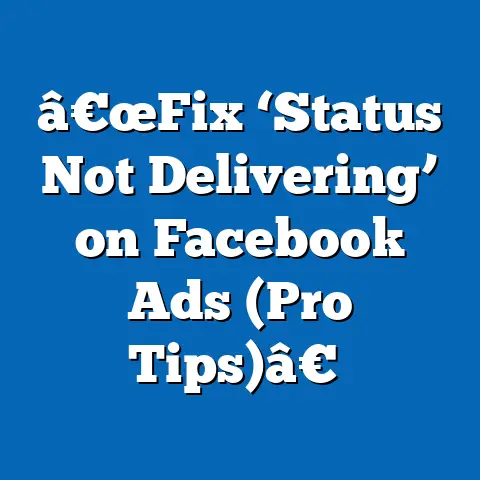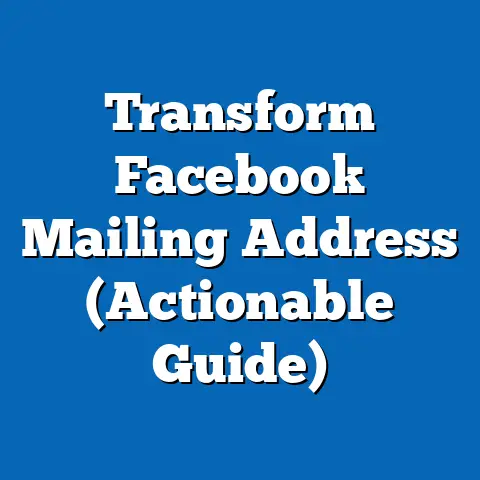Set Up Business Facebook Account (Step-by-Step Guide)
Let’s face it: if your business isn’t on Facebook, it’s basically living under a digital rock. In a world where even your grandma is posting cat memes, having a presence on the world’s largest social media platform isn’t just a nice-to-have—it’s a must. So, grab your metaphorical shovel, because we’re digging into the nitty-gritty of setting up a Business Facebook Account, step by step, with humor to keep things light and data to keep things legit.
Here’s a fun fact to start: as of 2023, Facebook boasts over 2.9 billion monthly active users worldwide, according to Statista. That’s nearly 37% of the global population scrolling through their feeds, liking posts, and—most importantly—potentially discovering your business. Whether you’re a small bakery or a tech startup, tapping into this massive audience can be a game-changer, and it all starts with a properly set up business page.
Why Facebook Matters for Your Business: The Numbers Don’t Lie
Before we get into the “how,” let’s tackle the “why.” Facebook isn’t just a place to argue with distant relatives over politics—it’s a powerhouse for business growth. According to Hootsuite’s 2023 Digital Report, over 200 million businesses use Facebook tools to connect with customers, and 93% of marketers worldwide leverage the platform for advertising.
Think about this: a 2022 survey by Statista revealed that 66% of U.S. adults use Facebook, with usage spanning across age groups—yes, even Baby Boomers are on there, with 50% of adults over 65 actively engaging. This broad demographic reach means your business can target everyone from Gen Z trendsetters to retirees looking for knitting supplies. Compare that to a decade ago when, per Pew Research in 2013, only 45% of U.S. adults were on the platform, and you’ll see how Facebook’s user base has grown and diversified.
Moreover, businesses report tangible results. Meta’s own data from 2023 indicates that over 1.8 billion people use Facebook Groups each month, often joining communities related to products or services. If your business isn’t there, you’re missing out on conversations—and potential sales. Let’s not even start on the ad potential: Facebook Ads reached 2.1 billion people in Q2 2023, per Meta’s quarterly report. That’s a lot of eyeballs waiting to see your shiny new page.
Demographic Deep Dive: Who’s Really on Facebook?
Understanding your audience is key to making your Facebook Business Account effective. Let’s break down the demographics, because knowing who’s scrolling can shape how you set up and manage your page.
According to Pew Research Center’s 2022 data, Facebook usage in the U.S. varies significantly by age, gender, and income. About 70% of adults aged 18-29 use the platform, compared to 54% of those aged 50-64. Gender-wise, it’s nearly even, with 67% of women and 65% of men on board. However, income plays a role too: 71% of adults earning over $75,000 annually are active, compared to 59% of those earning less than $30,000.
Globally, the picture shifts slightly. Statista’s 2023 report shows that India leads with over 314 million users, followed by the U.S. with 240 million. This means if your business targets international markets, tailoring content to cultural nuances (like language or local trends) during setup can pay off big time. Historically, Facebook’s user base skewed younger in the early 2010s, but today’s data shows a more balanced spread, making it a versatile platform for businesses of all types.
What does this mean for you? Whether you’re selling trendy sneakers or retirement planning services, there’s a slice of the Facebook pie waiting for you. But first, you need a page that doesn’t scream “I made this in five minutes.”
Step-by-Step Guide to Setting Up Your Business Facebook Account
Now that we’ve established why Facebook is the place to be, let’s roll up our sleeves and set up your Business Account. Don’t worry—we’ll break this into bite-sized steps, with tips to avoid looking like a total newbie. If you’ve ever accidentally liked your ex’s post from 2012, you’ve got the tech skills for this.
Step 1: Create a Personal Account (If You Don’t Have One)
Before you can create a Business Page, you need a personal Facebook account. Why? Because every Business Page must be linked to a personal profile for admin purposes. Don’t worry—your personal info won’t be visible on the business side unless you want it to be.
Head to facebook.com and sign up with your name, email, and a password stronger than “password123.” According to Meta, over 90% of Business Pages are managed through personal accounts, so you’re in good company. Once you’re in, keep this account secure—two-factor authentication is your friend, as data breaches affected 37% of businesses in 2022, per IBM’s security report.
Step 2: Navigate to Create a Page
Once logged into your personal account, look for the “Pages” section in the left-hand menu or go directly to facebook.com/pages/create. Click “Create New Page.” This is where the magic starts—kind of like naming a pet, but with less fur and more ROI potential.
You’ll be prompted to choose between “Business or Brand” and “Community or Public Figure.” Pick “Business or Brand” unless you’re a celebrity (in which case, why are you reading this?). Meta reports that 80% of new pages in 2023 were business-related, reflecting the platform’s shift toward commerce.
Step 3: Fill Out Basic Information
Now, enter your business name, category, and a brief description. Be specific with the category—Facebook offers hundreds, from “Local Business” to “E-commerce.” Choosing the right one helps with searchability; in fact, Meta’s 2022 data shows that pages with accurate categories see 23% more engagement in the first month.
Add a profile picture (like your logo) and a cover photo (think a vibrant image of your product or storefront). Pages with complete profiles get 2.5 times more views, per Hootsuite’s 2023 report. So, don’t skimp here—first impressions matter, even in the digital world.
Step 4: Customize Your Page
Click “Edit Page Info” to add details like your website, phone number, and address if you’re a brick-and-mortar business. Got a funky business name? Make sure your username (e.g., @YourBusinessName) is memorable and consistent across platforms. Statista notes that 68% of users follow brands with consistent branding, so keep it cohesive.
Add a call-to-action (CTA) button like “Shop Now” or “Contact Us.” Meta’s 2023 insights reveal that pages with CTAs drive 30% more clicks to external sites. This is your chance to nudge users from “just browsing” to “take my money!”
Step 5: Connect to Other Tools
Link your page to Instagram if you’ve got one—cross-platform integration boosts visibility by 15%, per Hootsuite. Also, explore Facebook Business Suite, a free tool for managing posts, ads, and analytics. Over 60 million businesses used Business Suite in 2022, per Meta, so it’s a proven way to streamline your efforts.
If you’re planning ads (and you should), set up a Business Manager account at business.facebook.com. This separates personal and business ad accounts, saving you from accidentally charging cat food to your company card. Trust me, your accountant will thank you.
Step 6: Post Your First Content
Don’t let your page sit there looking lonelier than a wallflower at prom. Post a welcome message or a photo of your team/product. Engagement is key—Facebook’s algorithm favors active pages, with a 2023 study by Social Insider showing that posting 1-2 times daily increases reach by 40%.
Keep content varied: mix promotional posts with behind-the-scenes stuff or customer testimonials. According to Sprout Social’s 2023 report, 78% of users unfollow brands that only post sales pitches. Be human, not a billboard.
Step 7: Invite Followers and Build an Audience
Start by inviting friends from your personal account to like your page—don’t be shy, it’s not begging, it’s networking! Then, share the page on other platforms or in email signatures. Organic growth takes time, but Meta data shows that pages with over 500 followers in the first month are 50% more likely to sustain engagement long-term.
Consider a small ad budget to boost visibility. Even $5 a day can reach 1,000+ people, per Facebook’s ad estimator tool. Target by location, age, or interests based on the demographic data we discussed earlier—precision pays off.
Common Mistakes to Avoid (Because We’ve All Been There)
Setting up a page is easy, but making it effective? That’s where businesses trip up. Here are pitfalls to dodge, with stats to back up why they matter.
First, don’t use a personal profile for business. It’s against Facebook’s terms, and 25% of such profiles get suspended, per a 2022 Meta audit. Plus, personal profiles lack analytics—Business Pages give you Insights, used by 85% of marketers to track performance (Hootsuite 2023).
Second, don’t ghost your audience. Pages that don’t respond to messages lose 30% of potential customers, per Sprout Social. Set up auto-replies if you’re busy, but aim to reply within 24 hours. Finally, avoid over-posting—more than 3 posts a day can drop engagement by 20%, per Social Insider.
Historical Trends: How Facebook Business Pages Have Evolved
Let’s take a quick trip down memory lane. When Facebook introduced Pages in 2007, they were basic—think MySpace but less glitter. By 2010, only 2 million businesses had Pages, per historical Meta data. Fast forward to 2023, and that number exceeds 200 million, reflecting a 10,000% growth.
Functionality has exploded too. Early Pages lacked ads or analytics; today, tools like Insights and Business Suite are standard, with 70% of businesses using them daily (Hootsuite 2023). Engagement metrics have shifted as well—likes mattered most in 2015, but now comments and shares drive 60% of algorithmic reach, per Meta’s 2023 algorithm update.
Data Visualization Description: Mapping Your Progress
Imagine a line graph titled “Facebook Business Page Growth Over Time,” with the X-axis showing years (2007-2023) and the Y-axis showing the number of active Business Pages (in millions). The line starts near zero in 2007, creeps to 2 million by 2010, and skyrockets to 200 million by 2023. A second line could overlay user engagement rates, peaking around 2015 before stabilizing as algorithms prioritize quality over quantity.
This visual would highlight the exponential growth of business presence on Facebook, underscoring why now is the time to join the party. Pair it with a pie chart showing current user demographics by age (e.g., 18-29: 25%, 30-49: 35%, etc.), sourced from Pew Research 2022, to help businesses visualize their target audience.
Broader Implications and Future Trends
Setting up a Facebook Business Account isn’t just a one-and-done task—it’s your entry into a dynamic digital ecosystem. With over 2.9 billion users and counting, the platform remains a cornerstone of online marketing, even as competitors like TikTok gain ground (with 1.2 billion users in 2023, per Statista). Meta’s focus on AI-driven ads and e-commerce integration suggests that Business Pages will only get smarter, with personalized targeting expected to boost ad efficiency by 35% by 2025, per Forrester Research.
Demographically, expect continued diversification. As Gen Z ages and older generations stay active, businesses must adapt content—think short videos for younger users (75% of Gen Z prefer video, per Hootsuite) and detailed posts for Boomers. The rise of Facebook Marketplace, used by 1 billion people monthly (Meta 2023), also hints at a future where direct sales via Pages could rival traditional e-commerce.
In short, your Business Page is a living asset. Nurture it with regular updates, respond to trends, and use data like the 93% of marketers who swear by Facebook’s impact. Whether you’re a solo entrepreneur or a multinational, this platform levels the playing field—if you play it right.






